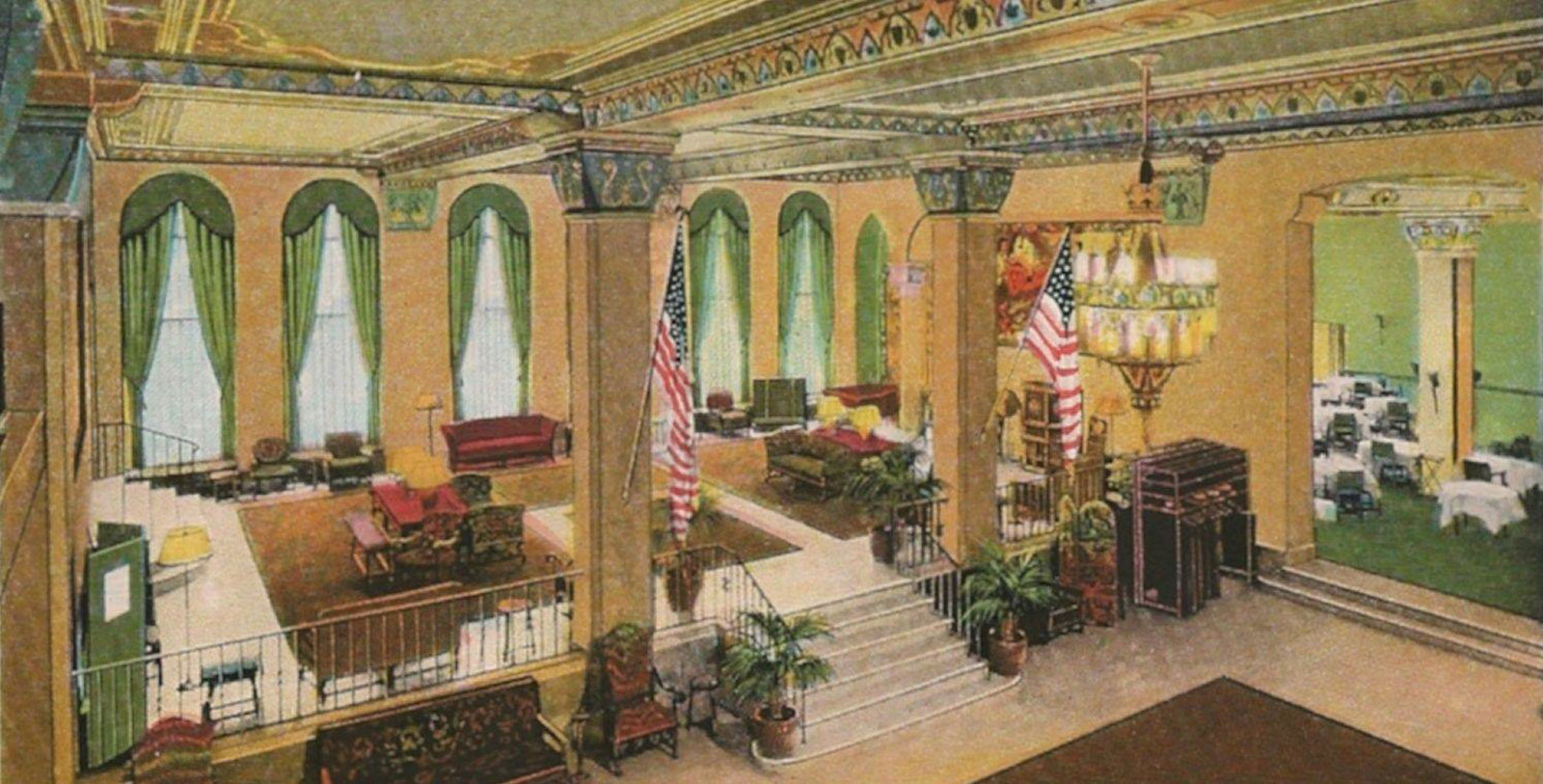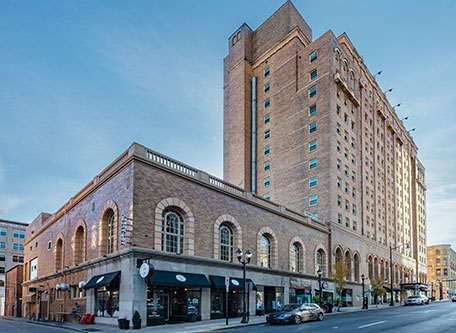Receive for Free - Discover & Explore eNewsletter monthly with advance notice of special offers, packages, and insider savings from 10% - 30% off Best Available Rates at selected hotels.
history
Discover the Historic Americus Hotel, which was designed by the talented architectural firm Ritter and Shay at the height of the Roaring Twenties.
Historic Americus Hotel, a member of Historic Hotels of America since 2022, dates back to 1926.
VIEW TIMELINEListed in the U.S. National Register of Historic Places, the Historic Americus Hotel is one of Pennsylvania’s most celebrated destinations. The hotel is located in the heart of Allentown, where it has stood as a cherished landmark for generations. This iconic historic hotel originally debuted at the height of the Roaring Twenties, where it functioned as the center of all social life in the community. Albert D. Gomery was the person responsible for deciding to create the building, forming the “American Hotel Realty Co.” to oversee the project alongside his brother and a few other entrepreneurs. Through the business, Gomery and his colleagues proceeded to purchase the lot of another historic destination—the American Hotel—and cleared it to lay a completely new foundation. The businessmen then awarded the design contract to Ritter and Shay, a prominent Philadelphia-based architecture firm that had created many renowned structures noted for their Chicago Commercial-style appearances. Ritter and Shay proceeded to develop a magnificent edifice that showcased a brilliant blend of Mediterranean design motifs. The implementation of such design elements reflected the desire of Gomery to utilize the nascent building as a metaphor for American growth and prosperity. As such, the architecture specifically acted as an overture to the mariners that first sailed to the Americas during the Age of Discovery. But the building’s very layout featured a variety of unique concepts, too, particularly in regard to the arrangement of the ground floor. Ritter and Shay specifically established a series of innovative bays next to the lobby that allowed for a ring of upscale shops to open. Even the structure’s initial slate of guestrooms featured a ingenious format that offered a better flow of natural light.
Gomery’s new hotel made its much-anticipated opening when the work concluded two years later in 1927. In another nod to the building’s overarching theme, he decided to name the structure as the “Americus Hotel” after Florentine explorer Amerigo Vespucci. To celebrate its grand debut, Gomery proceeded to organize an exhilarating soirée that many in Allentown yearned to attend. In fact, so many people attempted to make a reservation in advance of the party that the front desk staff had to eventually turn away prospective guests. Some 700 people ultimately attended the opening ceremony that September, who marveled at the polished marble floors, sparkling chandeliers, and beautiful Mediterranean-inspired artwork once inside. The party subsequently marked the beginning of a golden age for the Americus Hotel, which became a central fixture in Allentown’s thriving business district for four decades. Unfortunately, this success came to a gradual end toward the end of the century, as various owners struggled to keep it running. By the early 2000s, the constant mismanagement had forced the Americus Hotel to close. Now abandoned, salvation thankfully arrived when the Abdouche family purchased the structure from city officials in 2009. They endeavored greatly to restore the hotel back to its former glory. Significant pains were undertaken to save every aspect of the building’s historical character, right down to the most minute details. After months of continuous construction, the Abdouches finally reopened the revitalized building as the “Historic Americus Hotel” to great acclaim in 2021. Now a member of Historic Hotels of America, the Historic Americus Hotel has since regained its earlier prestige for only providing the best in luxury and comfort.
-
About the Location +
Located in the picturesque Lehigh Valley, the city of Allentown is among the most historic in the nation. Its history dates back to before the American Revolution, when an influential chief justice of colonial Pennsylvania, William Allen, began planning to form of a town during the mid-1760s. Stuck in a rivalry with the prominent Penn family, Allen yearned to create his own community that could check their growing influence in the area. In fact, Allen even allegedly hoped that the prospective settlement would supplant the Penns’ town of Easton as the county seat for the newly created Northampton County. Despite eventually losing his struggle with the Penn family, Allen nonetheless went about constructing a small, rural village near the Lehigh River that he subsequently called “Northamptontown.” The name did not last long though, as most of the residents informally referred to it as merely “Allen’s town.” Over time, that moniker coalesced into “Allentown,” although the official adoption of that title occurred decades later. Nevertheless, Allen entertained big aspirations for the location, hoping its proximity to the river would inspire an eventual rise in trade. But its unpredictable water levels made travel difficult, if not impractical, preventing such a transformation. Allentown thus remained tiny and pastoral in character, with its primary inhabitants being the German farmers that inhabited the surrounding countryside. (Today, those colonists are misleadingly remembered as the “Pennsylvania Dutch.”)
Allentown continued to be a little village right through the American Revolutionary War. Even though its size had not changed much, it still found itself involved in a few fascinating events. The town was a hotbed for American independence and heavily backed the Patriot war effort during the conflict. Historical records indicate that the local populace supported a workshop filled with more than a dozen military armorers, who provided much-needed munitions to the Continental Army. General George Washington and the rest of his staff even passed through Allentown after the Battle of Trenton, briefly resting at a spring located along a tributary of the Lehigh River called “Little Lehigh Creek.” Perhaps the most significant moment happened when the settlement became the hiding spot for the famed Liberty Bell. Following the Battle of Brandywine in 1777, the American capital of Philadelphia was wide open to an attack by the British Army. Pennsylvania’s legislature ordered that 11 huge bells in the city be hidden, including the iconic “Liberty Bell.” Then known as the “State House Bell,” it had sat atop the Pennsylvania State House—the very place where the Founding Fathers adopted the Declaration of Independence (and later, the U.S. Constitution.) (Most people know the Pennsylvania State House now as “Independence Hall.”) Two farmers subsequently hid the massive bell in the basement of Allentown’s Zion Reformed Church, where it stayed until the British evacuation of Philadelphia nine months later.
After existing as a quaint country village for generations, Allentown underwent dramatic expansion with the onset of industrialization in the 19th century. Beginning in the 1830s, Allentown gradually emerged as one of the country’s most prolific manufacturing centers. The debut of the Lehigh Canal initially in 1818 helped initiate this robust economic growth, only to be replaced by railroads on the eve of the American Civil War. Allentown’s factories specifically produced a variety of goods, too, such as clothing, beer, and furniture. But the greatest industry was iron ore smelting, which several prominent plants refined into pig iron. Unfortunately for the local iron industrialists, their businesses eventually collapsed during an economic calamity known as the “Panic of 1873.” Silk mills then became the predominant force in the local economy, with many operating well into the 20th century. While Allentown is no longer a major industrial hub today, it still continues to be one of Pennsylvania’s most vibrant communities. Indeed, the city is celebrated now for its rich historical character, especially among the nation’s cultural heritage travelers. For instance, numerous captivating attractions are located throughout the city, such as the Allentown Arts Museum, the Allentown Rose Garden, and the Miller Symphony Hall. Allentown is also close to several other destinations connected to the greater history of the Lehigh Valley, like the Bethlehem SteelStacks. the Burnside Plantation, and Moravian College.
-
About the Architecture +
While many architectural styles have influenced the appearance of the Historic Americus Hotel (including Italian Renaissance Revival and Art Deco), perhaps the most prevalent are Moorish Revival and Spanish Colonial Revival. Also referred to as “Neo-Moorish,” Moorish Revival itself was one of the Revivalist architecture forms originally established during the 19th century. In fact, Moorish Revival architecture was actually among the first Revivalist styles to ever appear, emerging throughout western and central Europe in the early 1800s. It eventually reached the United States and became immensely popular shortly after the American Civil War. Moorish Revival retained its earlier popularity among Americans at the turn of the century, too, before finally disappearing somewhat during the Great Depression. The architectural form drew its inspiration from the Moors—Muslims of Berber origin who had conquered almost all of the Iberian Peninsula during the Middle Ages. While their civilization was largely driven out of the region by the 15th century, many aspects of their culture endured in Spain and Portugal for generations thereafter. Indeed, one of the Moors greatest legacies were their grand architectural creations, which were influenced tremendously by Islamic design principles from the Middle East. The Moors specifically created brilliant edifices that embraced the concepts of rhythmic linear patterns, vegetative design, and elaborate geometric shapes. A combination of wood, stucco, and tiling—most notably “zellij”—constituted the buildings materials, although contemporary architects added more modern resources when attempting to emulate the aesthetic. Perhaps the greatest component of such buildings involved the “horseshoe arch”—a perfect curve that bulged outward from the base.
The other form that greatly defined the architectural style of the Historic Americus Hotel was “Spanish Colonial Revival.” Also known as “Spanish Eclectic,” this architectural form is a representation of themes typically seen in early Spanish colonial settlements. Original Spanish colonial architecture borrowed its design principles from Moorish, Renaissance, and Byzantine forms, which made it incredibly decorative and ornate. The general layout of those structures generally called for a central courtyard, as well as thick stucco walls that could endure Latin America’s diverse climate. Among the most recognizable features within those colonial buildings involved heavy carved doors, spiraled columns, and gabled red-tile roofs. Architect Bertram Goodhue was the first to widely popularize Spanish Colonial architecture in the United States, spawning a movement to incorporate the style more broadly in American culture at the beginning of the 20th century. Goodhue received a platform for his designs at the Panama-California Exposition of 1915, in which Spanish Colonial architecture was exposed to a national audience for the first time. His push to preserve the form led to a revivalist movement that saw widespread use of Spanish Colonial architecture throughout the country, specifically in California and Florida. Spanish Colonial Revival-style architecture reached its zenith during the early 1930s, even though a few American businesspeople continued to embrace the form for many years thereafter. Nevertheless, Spanish Colonial Revival has since remained one of America’s most iconic architectural styles, and many historical examples continue to survive across the nation today.
-
Famous Historic Guests +
Richard Nixon, 37th President of the United States (1969 – 1974)































